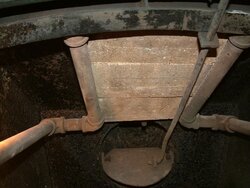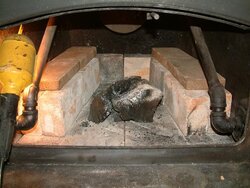Greetings from the (not yet) Wetcoast!
I have an Elmira double door insert. I don't know how old it is, but I think it was one of the first they built as there is no model number.
It's served me well the last five years or so, but I would like to improve its efficiency.
Why don't I just go and buy something new? Well, aside from the money, I like the look and configuration of the Elmira, particularly the double doors and the stove top.
I'm not crazy about the fan noise, but a new motor might help with that - I've rebuilt it once with new bearings and it gets cleaned and lubed at least once a year.
I've worked in welding and fabrication and I have the equipment to do the work, so what I'm wondering is what are my chances of rebuilding this unit to incorporate some secondary air inlets at the top of the firebox and actually get a significant improvement in heat and how much smoke I'm putting out?
I have a pile of new 1x5x10 (approx) firebricks I picked up for almost nothing so I don't anticipate any major costs except my time.
Comments or suggestions would be welcome! Thank you.
I have an Elmira double door insert. I don't know how old it is, but I think it was one of the first they built as there is no model number.
It's served me well the last five years or so, but I would like to improve its efficiency.
Why don't I just go and buy something new? Well, aside from the money, I like the look and configuration of the Elmira, particularly the double doors and the stove top.
I'm not crazy about the fan noise, but a new motor might help with that - I've rebuilt it once with new bearings and it gets cleaned and lubed at least once a year.
I've worked in welding and fabrication and I have the equipment to do the work, so what I'm wondering is what are my chances of rebuilding this unit to incorporate some secondary air inlets at the top of the firebox and actually get a significant improvement in heat and how much smoke I'm putting out?
I have a pile of new 1x5x10 (approx) firebricks I picked up for almost nothing so I don't anticipate any major costs except my time.
Comments or suggestions would be welcome! Thank you.



